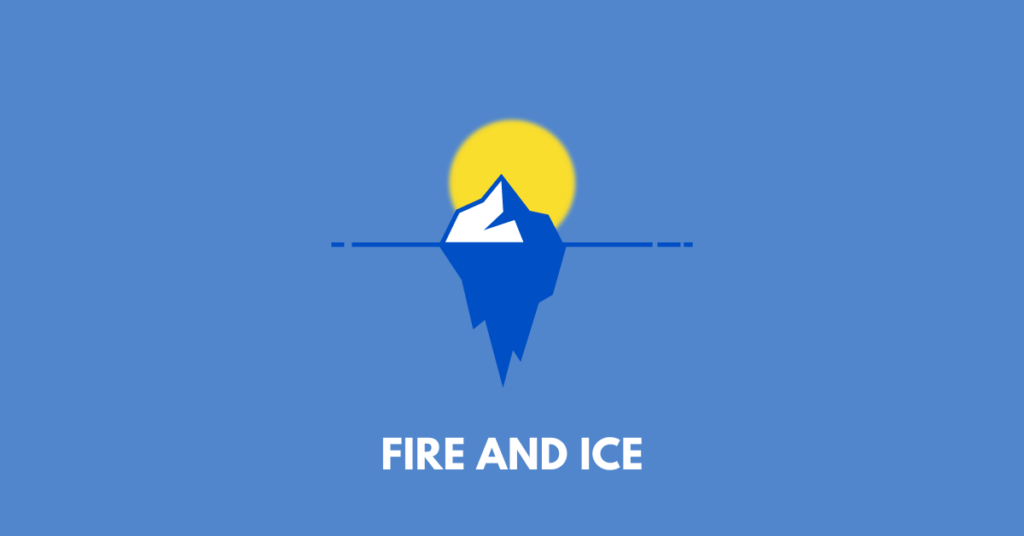Get summary, questions, answers, notes, PDF of the chapter/poem “Fire and Ice” which is part of TBSE (Tripura Board) class 10 English (First Flight) syllabus. However, the materials provided here should only be used for references and the students are encouraged to make modifications to them wherever they can and need.

Summary
The poem “Fire and Ice” is a short but powerful piece of writing that explores the end of the world and the human emotions that can lead to destruction. The poem is divided into two stanzas. In the first stanza, the speaker presents the idea that the world might end in either fire or ice. He states that he has heard people express both possibilities, and he wonders which is more likely. The speaker’s own opinion on the matter is that he favours fire, which he associates with desire and passion. He believes that fire is a more intense and powerful force than ice, and therefore a more fitting end to the world. However, he acknowledges that ice is also a formidable force that could bring about the end of the world if it had to happen again.
The poem uses fire and ice as symbols for two emotions: desire and hate. Fire represents desire, which can be a positive or negative force depending on how it is used. Desire can inspire people to achieve their goals, but it can also lead them to greed, lust, or obsession. Ice represents hate, which is always negative and destructive. Hate causes people to feel indifferent, resentful, or hostile toward others, which can lead to violence and destruction.
The poem is also significant in its historical context. Robert Frost wrote “Fire and Ice” in 1920, just after the end of World War I. This was a time when people were grappling with the aftermath of a devastating war that had killed millions and caused widespread destruction. Many people feared that another war or some catastrophic event, like a nuclear explosion, could bring about the end of the world. The poem reflects these anxieties and encourages readers to consider their own beliefs about how the world might end and what emotions drive their actions.
Thinking about the poem
1. There are many ideas about how the world will ‘end’. Do you think the world will end some day? Have you ever thought what would happen if the sun got so hot that it ‘burst’, or grew colder and colder?
Answer: I think that the world will eventually come to an end, but it is difficult to predict when or how that will happen. There are various scientific theories about how the world could end, such as the sun expanding and engulfing the Earth or a catastrophic event like a large asteroid impact. If the sun were to get so hot that it “bursts” or grows colder and colder, it could have catastrophic effects on life on Earth, and life as we know it could cease to exist entirely. However, it is important to note that these are just theories, and there is no way to predict the future with certainty.
2. For Frost, what do ‘fire’ and ‘ice’ stand for? Here are some ideas:
greed, avarice, cruelty, lust, conflict, fury, intolerance, rigidity, insensitivity, coldness, indifference, hatred
Answer: In the poem, the ideas that “fire” and “ice” stand for in Robert Frost’s poem are not explicitly stated. However, the poem suggests that “fire” and “ice” represent two opposing forces that could potentially lead to the end of the world. Some readers interpret “fire” as representing desire, passion, or even love, while others interpret it as representing destruction, anger, or violence. Similarly, “ice” has been interpreted as representing hatred, indifference, or coldness, as well as representing a force of nature that could bring about the end of the world. Ultimately, the poem leaves the interpretation of “fire” and “ice” up to the reader, and there may be many different ideas about what they represent.
3. What is the rhyme scheme of the poem? How does it help in bringing out the contrasting ideas in the poem?
Answer: The rhyming scheme of the poem is abaa, cdcdc. The rhyme scheme employed in this poem effectively highlights the contrasting ideas of “fire” and “ice” that the poet presents. According to the poet, both fire and ice are potential agents of the world’s destruction. While fire represents desire, and thus could lead to the end of the world, Frost also inserts the symbol of ice to signify that a lack of warmth and compassion for others could also be enough to bring about the end. In the second stanza, the poet asserts that the hate present in the world is sufficient to bring about destruction even through the coldness of ice. The rhyme scheme emphasizes the opposing forces and potential outcomes while underscoring the gravity and finality of the world’s end.
Get notes of other classes and subjects
| NBSE | SEBA/AHSEC |
| NCERT | TBSE |
| WBBSE/WHCHSE | ICSE/ISC |
| BSEM/COHSEM | MBOSE |
| Share Feedback | Question Papers |

